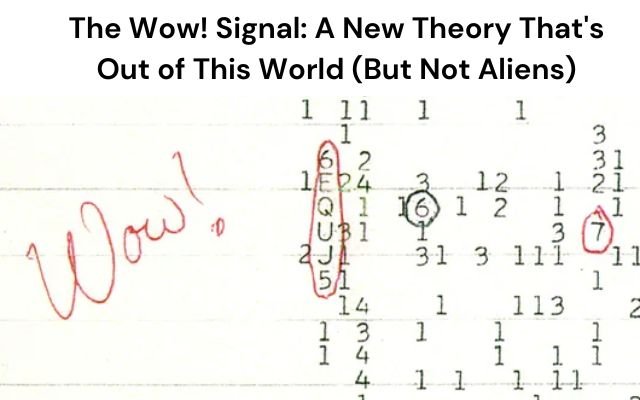The Wow! Signal: A New Theory That’s Out of This World (But Not Aliens)
Discover the latest theory behind the Wow! Signal: a groundbreaking idea that might explain this mysterious signal—no aliens involved.

The mystery of the Wow! Signal, a strange radio burst detected in 1977, might finally be solved after 47 years. Recent studies suggest it could have been caused by a natural event, like a hydrogen cloud being energized by a magnetar flare, rather than an alien message. While this may rule out extraterrestrial life, it provides valuable insights into rare astronomical phenomena, offering a new understanding of the universe.
Astronomers studying red dwarf stars have recently noticed something in the background of their observations that could help solve a mystery that has puzzled scientists for over 40 years. This discovery might provide a new opportunity to learn more about rare astronomical events.
Table of Contents
The Mysterious Wow! Signal
Back in the 1970s, Big Ear telescope at Ohio State University was used to scan sky for unusual signals, possibly from alien civilizations. In 1977, a volunteer named Jerry Ehman found something so strange in the data that he circled it and wrote “Wow!” beside it. This 72-second signal has since been known as Wow! signal. While many believe it’s unlikely to be from aliens no one has been able to offer solid explanation for it.
Why the Wow! Signal Is So Fascinating
What makes Wow! signal so fascinating is that, despite advancement in technology, no similar signals have been detected—until now. A team of scientists has reported finding multiple signals that resemble original Wow! signal, although these are 60 to 100 times weaker. While their findings are still awaiting peer review they have shared their research online, sparking excitement in the scientific community.
This new discovery could bring us closer to understanding what caused the Wow! signal and might open doors to learning more about the universe’s most mysterious events.
New Observations from Arecibo Observatory
Professor Abel Méndez from the University of Puerto Rico recently reviewed data collected by the Arecibo Observatory between 2017 and 2020. The observatory, with its giant telescope, was observing nearby red dwarf stars to learn if their planets could be habitable. While studying Teegarden’s Star, Méndez and his team noticed four interesting signals in the background. They also found similar signals in two other cases.
Understanding the Signals
When scientists talk about “signals,” they don’t necessarily mean messages from aliens. In this context- signal is anything that isn’t just random noise. Signals that Méndez and his co-authors discovered are likely from cold hydrogen clouds in space. These clouds emit signals that can be detected by powerful telescopes like Arecibo.
The Significance of the 1420 MHz Frequency
The Big Ear telescope, which detected the famous Wow! signal in 1977, was also searching for signals near the 1420 MHz hydrogen emission line. This frequency is called “the waterhole” because it’s thought that alien civilizations might use it to communicate, much like animals gather around a waterhole. The Wow! signal was unusual because it was brief and detected in a very narrow range of radio frequencies. These characteristics are rare for natural space phenomena but are expected in alien communication.
A New Hypothesis for the Wow! Signal
Méndez and his team believe the Wow! signal might have been caused by hydrogen cloud being briefly energized by something fast and powerful like a magnetar flare. Magnetars are a type of neutron star known for their intense magnetic fields. This idea makes sense because hydrogen cloud could emit signals in narrow band that Big Ear telescope detected.
Connecting Hydrogen Clouds and the Wow! Signal
Until now, no one had connected these kinds of hydrogen cloud signals with the Wow! signal. Méndez explained that while signals from cold hydrogen clouds have been known for decades, they are rarely seen because they require a large instrument like Arecibo to detect them. The team only made this discovery because Arecibo was operating in “drift mode,” allowing them to detect signals as objects in space slowly passed by.
The Rarity of the Wow! Signal’s Brightness
Big Ear telescope couldn’t have detected weaker signals like the ones Méndez found. The Wow! signal was unusually bright which might have been a rare occurrence. However, Méndez noted that signals from hydrogen clouds could temporarily become brighter due to strong radiation sources in background potentially explaining Wow! signal’s intensity.
The Impact of This New Theory
While some enthusiasts may be disappointed by any explanation of Wow! signal that doesn’t involve aliens, for professional astronomers, this new theory could be a significant breakthrough. If confirmed, it not only offers an exciting alternative to the alien hypothesis but also opens up new avenues for understanding the universe.
Potential Insights and Future Research
This explanation would provide astronomers with a useful reference when examining any future mysterious signals. It could also offer insights into behavior of cold hydrogen clouds and the forces that might stimulate them. Preprint suggests that when a hydrogen cloud is stimulated it can lead to a chain reaction where photons trigger the release of more photons. This process could cause a sudden and intense increase in brightness which might alert astronomers to rare and important astronomical events.
The First Detection of a Hydrogen Maser Flare?
If this theory is correct, Wow! signal could represent the first detection of a phenomenon known as an astronomical hydrogen maser flare. Masers are similar to lasers but they emit microwaves instead of visible light. First astronomical hydrogen maser flare was identified in 1989 and has only been observed few times since. These events usually occur at different emission lines than 1420 MHz frequency of the Wow! signal, making this instance unique.
- Mental Health Matters: Breaking the Stigma and Finding Solutions
- Over 4 Billion People Face Clean Water Shortage
The Role of Arecibo and Future Prospects
Although 1420 MHz masers have been created in laboratories, this would be only known occurrence of one in space. Unfortunately with collapse of Arecibo Observatory which played a crucial role in such discoveries, continuation of this research now relies on much smaller instruments. Despite this, study of red dwarf stars and their planets continues, with hopes of uncovering more about these rare astronomical events.



